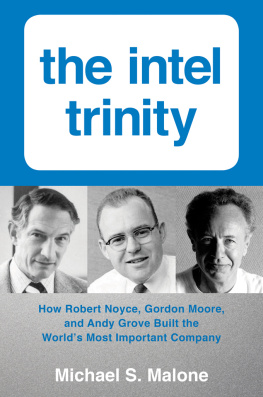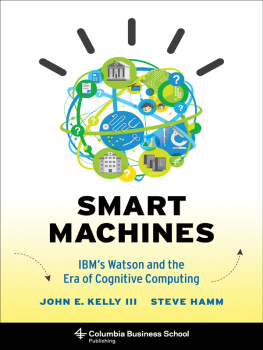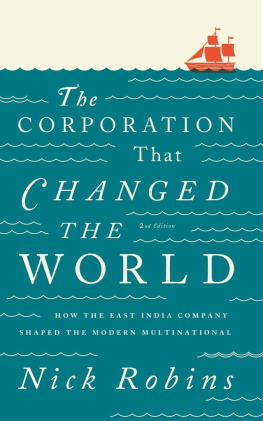Making the World Work Better
The Ideas That Shaped a Century and a Company
IBM PressPearson plc
Upper Saddle River, NJ / Boston / Indianapolis / San Francisco / New York / Toronto / Montreal / London / Munich / Paris / Madrid / Cape Town / Sydney / Tokyo / Singapore / Mexico City
ibmpressbooks.com
The authors and publisher have taken care in the preparation of this book, but make no expressed or implied warranty of any kind and assume no responsibility for errors or omissions. No liability is assumed for incidental or consequential damages in connection with or arising out of the use of the information or programs contained herein.
Copyright 2011
by International Business Machines Corporation.
Cover and interior design:
VSA Partners, Inc.
Editor:
Mike Wing
Copy editor:
Pennie Rossini
Fact checker:
Janet Byrne
Indexer:
Robert Swanson
The following terms are trademarks of International Business Machines Corporation in many jurisdictions worldwide: IBM, IBM Press, THINK, Blue Gene, CICS, Deep Blue, Lotus, PROFS, InnovationJam, Cognos, ILOG, Maximo, Smarter Planet, Global Business Services, World Community Grid, On Demand Community, Many Eyes, DB2 and Blue Gene/L. A current list of IBM trademarks is available on the web at Copyright and trademark information at www.ibm.com/legal/copytrade.shtml.
Intel and Pentium are trademarks or registered trademarks of Intel Corporation or its subsidiaries in the United States and other countries.
UNIX is a registered trademark of The Open Group in the United States and other countries.
Linux is a registered trademark of Linus Torvalds in the United States, other countries, or both.
Other company, product or service names may be trademarks or service marks of others.
Library of Congress Cataloging-in-Publication Data is on file.
All rights reserved. This publication is protected by copyright, and permission must be obtained from the publisher prior to any prohibited reproduction, storage in a retrieval system or transmission in any form or by any means, electronic, mechanical, photocopying, recording or likewise.
ISBN-10: 0-13-275510-6
ISBN-13: 978-0-13-275510-8
Text printed in the United States on recycled paper at R.R. Donnelley in Crawfordsville, Indiana.
First printing June 2011
Of Change and Progress
Samuel J. Palmisano
CHAIRMAN, PRESIDENT AND CHIEF EXECUTIVE OFFICER IBM CORPORATION
One simple way to assess the impact of any organization is to answer the question: how is the world different because it existed?
The date of this volumes publication, June 16, 2011, is a meaningful one for IBM. On it, we celebrate our centennial as a corporation. For IBMers todaywomen and men who have lived through an eventful part of that historythat means reconnecting to a storied past, and understanding its implications for a still-unfolding story.
But we believe the lessons of our history apply more broadly. Whether you seek to understand the trajectory of technology or to build and sustain a successful enterprise or to make the world work better, there is much to learn from IBMs experience. And because these lessons have significance that goes far beyond our companyand because we wish to understand them better ourselveswe decided to do something different from a typical commemorative publication.
Rather than simply chronicle the companys long list of achievements, we reached out to three journalists who have covered our industry for years. In fact, all of them have interviewed me at one time or another. They have a wealth of knowledge about technology, business and history, and each one offers a distinct perspective on what it all means. Plus, theyre all crack reporters. We asked them to take a deep dive into three aspects of how the world has changed and to explore IBMs role in that change.
I have been fascinated by the results of their researchin particular, the underlying beliefs they discovered. Our company, of course, became famous for Thomas Watson Sr.s Basic Beliefs, the principles that were intended to guide IBMers behavior. And in recent years, we have come together as a workforce to reexamine and redefine our core values. Interestingly, what the research for this book uncovered was another set of ideas that were never written down, but that nonetheless have pervaded IBM from its birth up to the present day.
One of those has to do with the nature of computation and information science. Kevin Maneys exploration of the history of this technology and the industry it spawned reminds us that it is a lot richer and more nuanced than most people today realize. If your knowledge comes from the media, you might think that the story of IT is divided into two phaseshardware and software. Or that it all falls into pre-Internet and post-Internet eras. Kevins longer lens does much to clarify the far more multidimensional history of computation, IBMs role in shaping it and how its foundational components are advancing and recombining today.
But he does even more. As Kevin argues, the core elements of computing mirror key dimensions of the human brain. The story of their evolution shows how our thinking changes the tools we create, and how the tools we create then change the way we think. And this deeper understanding makes it clear that scientific truth isnt either/or, and discovery isnt simply before-and-after. At the start of the twenty-first century, we find ourselves at an inflection point in both scientific thought and technological capabilitya moment whose implications leaders and citizens must study if they wish to ride the waves of our planets information-shaped future.
Similarly, Steve Hamms look at IBMs growth into a new kind of business institution doesnt just chronicle the triumphs, mistakes and repeated reinvention of one company. Steve offers intriguing new perspectives on some well-worn truisms. For one: the emergence of an information-based economy. We are all familiar with the shift from atoms to bits as the source of economic value. But it has further implications. Because information knows no borders, it also leads inevitably toward a global economyand toward the increasing convergence of business and society. We learn how becoming global is about a lot more than geography, a lot more than simply having a presence all around the world. Finally, this narrative underscores how an enduring organizational culture isnt just a fact of nature but a deliberate act of its peopleone that involves a lot more than dress codes and team-building exercises.
Neither Thomas Watson nor his son had available to him the sophisticated language we use today to describe this complex systemmuch less the scientific and business disciplines that have arisen over the past half century to study it. What they did have was the intention to build a particular kind of enterprisea set of gut impulses, if you will, about what a business should be. As a result of those impulses, IBMs experience through the twentieth century did much to shape the modern corporation. And as Steves essay persuasively argues, what IBM is still becoming offers interesting perspectives on the new ways any organizationin business, government, education or beyondcan answer basic questions like: How does it create value? How does it attract, develop and retain people? How does it organize and manage itself? What role does it play in society at large? What makes it unique?
Finally, Jeff OBriens research reveals compelling examples of what is required to accomplish the hard work of progress in an increasingly complex and interconnected world. When you look at the work IBM and others have done decade after decadework that is accelerating todaya certain pattern of activity and mode of thought emerge. Technology alone, no matter how powerful, cannot bring about systemic change. It turns out that deliberately changing the way the world works requires a broader, longer-term approach, with the mastery of a few basic steps.






